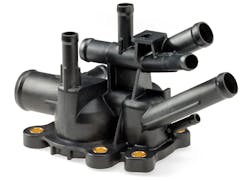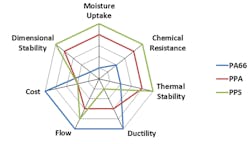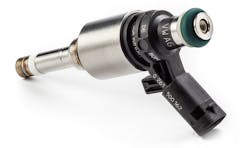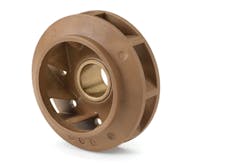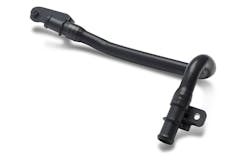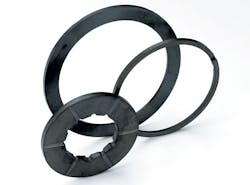Automakers are committing significant resources to develop electric, autonomous, and hybrid vehicles. These OEMs also need to meet rising demand for greater connectivity in every class of car, including vehicles with internal combustion engines. Automotive lightweighting, a design strategy that seeks to reduce vehicle weight, isn’t new. It has, however becoming more important for reasons beyond fuel efficiency and emissions reductions. Today, engineers want lightweight materials that improve design, manufacturability, and the performance of molded and machined parts.
For decades, automotive designers have been replacing heavier metal components with engineering plastics and fiber-filled composite versions. This practice is now broadening as automakers look beyond exterior components and interior fixtures. Thanks to advances in polymer technology, engineers have a wider range of new and lighter options for drivetrain and underhood components. Importantly, these materials offer greater design freedom and fit in well with the lightweighting strategies that go beyond replacing metal with plastic.
This complex 10-port water outlet made of Solvay’s heat-stabilized polyphthalamide (PPA) resists water and glycol at 135°C for 5,000 hours. The material saved 25% in costs and almost a pound in weight compared to a metal version, and its pull-pass barb molding capability reduced the number of parts.
Designers who take a system-level approach in all automotive segments are discovering new possibilities. For example, the unique combination of advanced polymers’ properties are improving the slot liners and magnet wire insulation in electric (EVs), hybrid electric (HEVs), and plug-in hybrid electric vehicles (PHEVs). In turn, non-metal materials reduce the weight and size of traction motors while improving their efficiency. In all types of cars, replacing several metal parts with a single plastic part reduces vehicle weight while reducing the amount of assembly needed.
Recent advances in polymers let automotive designers consider different manufacturing methods. Most plastic parts are injection molded, but plastic coolant tubing is extruded, thermoformed, and spin welded onto connectors. Plastic thermoforming also makes exterior components such as hoods and spoilers. In addition, advanced polymers work well with adhesives and can be machined from stock shapes or printed via additive manufacturing (aka 3D printing) during prototyping. Plastic composites with significant glass, mineral, or carbon fiber content can be precision machined with tight tolerances.
Automotive designers may appreciate the design flexibility and manufacturing benefits advanced polymers provide, but high temperatures and exposure to chemicals or fluids might make metals seem like the only choice for especially demanding applications. This isn’t the case, however, as demonstrated by recent innovations in polymers for automotive electrical systems and electronics, internal combustion engines, fuel injection systems and assemblies, transmissions, EV batteries and cooling, and electrified drivetrains.
These newer materials might seem like just the latest chapter in the history of automotive lightweighting, but polymers aren’t just replacing metals. They’re replacing other plastics, too. When selecting materials, then, designers need to think beyond plastics vs. metals and compare the performance profiles of high-performance specialty polymers.
Spider graphs like this one let designers compare and contrast characteristics of related materials. This one looks at polyphthalamide (PPA), polyamide 66 (PA66), and polyphenylene sulfide (PPS).
Plastics in Vehicles
In Plastics and Polymer Composites in Light Vehicles, a report from the American Chemistry Council, the industry trade association explains that in 1960, the average light vehicle contained just 20 lb of plastics and polymer composites. By 1990, this had climbed to 191 lb, and by 2018, non-metal materials averaged 342 lb for 8.6% of total vehicle weight. Today, plastics typically make up 50% of the volume of a light vehicle but less than 10% of its weight.
Since the 1960s, plastics have changed auto body designs and let OEMs adopt modular assembly practices while lowering production costs. Plastic parts for automotive interiors promoted not only comfort and styling, but also ergonomics and noise control. When car buyers became more concerned about auto safety, plastics were added to door modules to strengthen side-impact resistance and plastic foams added to automotive cavities to increase occupant safety and reduced noise, vibration, and harshness (NVH).
Today, automotive plastics are used with brake pistons, wheel speed sensors, and parts such as the solenoids and plungers in the hydraulic control units of anti-lock brakes. Automotive plastics in the chassis provide strength and rigidity while absorbing energy that can cause NVH. In addition, specialty polymers are used in powertrains, which include the internal combustion engines, batteries, and motors.
Many automotive fuel systems and engine components also use plastics instead of metal. During the last several decades, in fact, plastics have helped transform automotive electrical systems. For example, plastic components support the operation, interconnection, and housing of printed circuit boards, connectors, sockets, switches, wires, and cables. As computer chips regulate and monitor automotive subsystems, specialty polymers can be found in everything from global positioning systems for navigation to audio systems for entertainment.
Today’s cars contain electrical and electronic components that perform many important functions, but sensors are especially critical. For instance, anti-lock brake sensors monitor wheel speed, oxygen sensors determine how much fuel is needed to run the engine efficiently, and other sensors monitor coolant levels. Advanced polymers support these and other automotive sensors while withstanding the high temperatures and harsh environments associated with such systems.
As automotive electronics become smaller and more densely packaged, advanced polymers have started to replace more traditional engineering ones such as standard polyamides. For example, Solvay produces a polyphthalamide (PPA) that provides an attractive balance of properties compared to polyamide 66 (PA66) and polyphenylene sulfide (PPS). PPA maintains its properties in humid environments, offers superior dimensional and thermal stability, and provides greater resistance to a broad range of chemicals, including brake fluid.
Advanced polymers also improve fluid monitoring in electrified drivetrains. Some of these materials are inherently heat stable and do not require additives to inhibit or prevent thermal degradation. There are also polymers with non-metal heat stabilizers that can prevent thermal degradation if needed. For example, Solvay’s PPA contains an organic stabilizer that’s free of migrating metal that could short-circuit an electrical system.
Designers rely on advanced PPS in vehicle electrical systems and electronics applications because they have long-term resistance to temperatures up to 392°F (200°C) and short-term resistance to temperatures up to 500°F (260°C). PPS offers the broadest resistance to chemicals of any high-performance plastic and can combine dimensional stability and inherent flame retardancy with support for precision molding to tight tolerances with high reproducibility. With its combination of properties, PPS is an excellent candidate for electrical and electronic components in coolant systems and for oil and fuel system components.
Specialty polymers, such as Solvay’s high-performance polyetheretherketones (PEEK), are often specified for electric water and oil pumps. They reduce weight while offering excellent chemical resistance for durable, long-term performance. They also have dimensional stability needed for tight tolerances that can maintain high pumping efficiencies.
Fuel injector O-rings made from Solvay’s fluoroelastomers (FKM) offer good performance in sealing applications for aggressive chemical and high-heat environments. The material also has a wide operational temperature range and remains flexible even at sub-zero temperatures.
Gas Engines
Advanced polymers can now be found in ducts and sensors for turbochargers and superchargers. Because these devices must withstand high temperatures and corrosive exhaust gases, they need materials that resists both. Fluoroelastomers (FKM) can connect ducts on the hot sides of superchargers and turbochargers. In addition to cutting weight, FKM supports manufacturability and has low-temperature capabilities. For hot-side air ducts in high-temperature diesel applications, PPS is used.
Another area for weight reduction is fluid handling tubes. For example, PPS extrusion grades are significantly lighter than the more expensive metal/rubber coolant lines. PPS is well suited for flexible tubing with diameters from 8 to 22 mm with wall section thickness from 1 to 1.7 mm. These are used in post-extrusion thermoforming, a process that turns out items with predefined shapes from heated materials.
As a metal-replacement material, PPS exhibits high melt strength and thermal stability, along with enhanced tensile and impact strength. Unlike metal tubes, specialized grades of extruded PPS do not require coating because they resist road salt, oil, gasoline, and other chemicals. Along with its lighter weight and chemical resistance, PPS also has excellent thermal resistance, making it a good choice for connectors and brackets in hot, cramped engine bays. In some designs, PPS also helps eliminate heat shields. And brackets can be overmolded onto the tubing to make a complete assembly.
Oil pump housings also make good use of advanced polymers. Traditionally, these components consisted of lightweight aluminum. However, designers now have polymers for even more weight reduction and a better balance of mechanical properties under high-temperatures and pressures. Solvay’s 30% carbon-fiber-reinforced polyaryletherketone (PAEK) compound can meet these demands and is stiffer than PEEK at 150°C to 200°C. This high-end PAEK also has excellent machinability and fatigue resistance.
Cam sprockets are another area for specialty polymers. In internal combustion engines, these chain-driven sprockets attach to one end of the cam shaft and, along with the timing belt, help to maintain proper timing for optimal engine performance. Yet cam sprockets are also exposed to high torque, extreme temperatures, vibration, dirt, automotive fluids, and road salt. If these parts overheat, chip, lose their shape, or fail to perform reliably under load, the engine timing won’t work properly.
Most cam sprockets are made of sintered steel or aluminum, but some are made from thermoset phenolic polymers. An alternative to all these materials is polyamide-imide (PAI). Solvay’s PAI materials deliver the highest strength, stiffness, and fatigue resistance of all thermoplastics at temperatures up to 525°F (274°C). It has a specific strength of 5.4 x 105 in-lbf/lb (1.4 105 J/kg) and a specific stiffness 6 x 107 in-lbf/lb (15 106 J/kg). By contrast, stainless steel delivers a specific strength and stiffness of 3.1 x 107 in-lbf/lb (0.8 106 J/kg), and 9.7 x 107 in-lbf/lb (24 106 J/kg), respectively.
Advanced polymers also offer advantages for the design, manufacture and performance of fuel-handling components. Their lighter weight supports increased fuel efficiency, but plastics that resist rupture and provide high impact strength also prevent fuel delivery systems from leaking or corroding. But as engine pressures and temperatures continue to increase, designers need next-generation metal replacements to withstand demanding conditions while performing consistently in all environments and climates.
Fuel rails, the high-pressure tubing that sends fuel to injector nozzles, are traditionally made of steel. If there is no fuel injection, however, plastic fuels rails can be used. PPA and PPS reinforced resins resist alcohol-based fuels at high temperatures and pressures. These glass-fiber reinforced compounds add dimensional stability and let fuel rails be injection molded as a single piece. By contrast, traditional metal rails are typically six-part welded steel assemblies.
For fuel injection assemblies, FKM can be fabricated into O-rings with excellent sealing force and fuel compatibility at high temperatures while remaining flexible. Solvay’s peroxide-curable FKM grades offer the lowest cold-temperature performance and best fuel compatibility among all fluoroelastomers. More specifically, the material’s glass transition (Tg) temperature of −40°F (−40°) helps ensure that O-rings in high-performance engines perform reliably within design limits even under extreme pressure.
In conventional vehicles, the master cylinder converts force into hydraulic pressure and controls slave cylinders that disengage the clutch from the engine. In a dual concentric slave cylinder (DCSC), sealing rings must withstand extreme loads each time a car shifts gear. Historically, sealing rings have been either aluminum or engineering polymers. Today, specialty light-weight polymers provide better wear resistance and dimensional stability.
High performance PAI lets DCSC seal rings ensure consistent contact with the cylinder’s chamber walls, which minimizes friction and ensures cleanliness in a transmission’s high-cycle, high-pressure environment. This polymer makes for tight, durable seals that let the DCSC operate consistently regardless of constant exposure to dirt, dust, debris, transmission fluids, and temperatures cycling between −40°F and 320°F (−40°C and 160°C).
PAIs can also be made into locking devices that maintains precise radial positions within the DCSC throughout the transmission’s life. This specialty polymer contributes little friction and exhibits extremely low wear. Its excellent lubricity and fatigue resistance also lets the locking device withstand millions of loading cycles from the clutch.
Thrust washers, another transmission component, can also use PAI because of its performance in dry and lubricated environments due to its excellent wear resistance and dimensional stability at elevated temperatures and pressures. It also resists creep and chemicals, including strong acids and most organics. All this makes it well suited for severe service environments with extended performance requirements.
Water pump impellers made of Solvay’s polyphenylene sulfide (PPS), resist water/glycol at 140°C for 5,000 hr. Flexible extruded coolant lines made from PPS can replace heavier, more-expensive metal/rubber cooling lines, be used for more complex routing in cramped engine bays, and eliminate the need for heat shielding.
EV Vehicles
Lightweight metals such as aluminum are used in many EV batteries. They resist burning and protect against electromagnetic interference (EMI), a growing challenge for applications with densely packaged electronics. Metals also provide dependable mechanical and dimensional properties, but they come with trade-offs. Compared to a battery pack where just some parts are plastic, the all-metal unit weighs significantly more.
To replace metal parts, automotive designers have turned to advanced polymers for electric insulation that won’t compromise EV batteries’ mechanical and dimensional properties. When making parts, specialty polymers offer lower initial mold-shrink and warpage tolerances. They also have lower moisture absorption for dimensional stability and come in UL 94 V-0 grades for flame resistance.
For battery direct-immersion cooling, advanced perfluoropolyethers (PFPE) provide high thermal stability, a wide range of operating temperatures, good dielectric properties, and excellent chemical inertness. This fluorinated heat-transfer fluid is well suited for battery packs’ liquid coolant as it has no flash or fire point. PFPE is also compatible with standard metals and plastics; maintains stable properties over time; and reduces the risk of short circuits, corrosion, and cross-contamination.
Specialty polymers that lower the weight of cars and trucks are also reducing NVH in electric vehicles. As more people drive EVs, engineers need to silence noises that wouldn’t be heard over the sound of a gas engine. Plus, EVs shut down their engines when stopped but do not shut off various fans that whirl and whine. Because lightweight plastics in many EVs are more susceptible to vibration, advanced specialty polymers are being used to minimize or eliminate NVH.
In EVs, pumps are often also electrical and must perform under the frequent stop/start conditions just mentioned, which introduces greater friction and wear. Because fluids used with these pumps have a relatively low viscosity, lubrication is an issue. New ultra-low viscosity (ULV) transmission fluids are more energy-efficient but lack the lubricity some pump designers expect. For bushings and bearings in this higher-friction environment, components made from high-performance PEEK thermoplastics can do the trick.
Other advanced polymers compatible with ULV transmission fluids include several grades of Solvay’s PPS. They work with UL 25 transmission fluid and have been evaluated under ISO and ASTM methods to measure changes in mechanical properties. These materials are filled with different percentages of glass fiber and exhibit minimal changes to tensile strength and elongation.
Transmission thrust washers and seal rings made of Solvay’s polyamide-imide (PAI) perform well in dry and lubricated environments, thanks to the material’s wear resistance and dimensional stability.
The Road Ahead
Today, many auto designers are seeking new ways to reduce vehicle weight using plastics and plastic composites. They are also considering ways to replace plastic and composite parts with advanced, higher-performing polymers that meet more demanding requirements or contain low-density additives, alternative fibers and nanoparticles. Advanced polymers are used in all cars and trucks and increased safety requirements and self-driving cars provide even more opportunities.
By taking an overall approach instead of simply replacing metals with plastics, engineers can reduce the weight of vehicles, improve performance and safety, and gain greater design freedom. It also reduces assembly times and costs by reducing part counts. Whether the future of the automobile is hybrid, electric, autonomous, or something else, advanced polymers will play an important role.
Sandra McClelland is sales development manager-NAFTA Automotive at Solvay’s Specialty Polymers business unit. Mark Wright is global automotive market manager for Solvay’s Specialty Polymers and Composite Materials business units. For more information on advanced polymers visit Solvay.com or e-mail [email protected] or [email protected].

